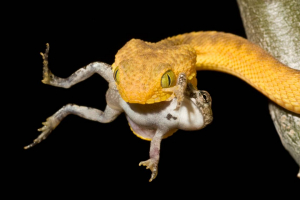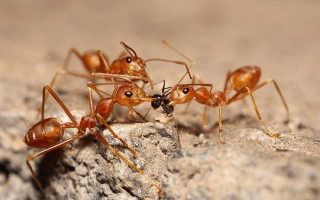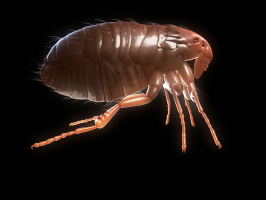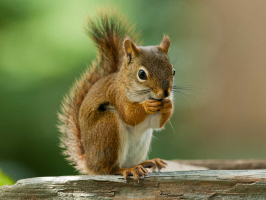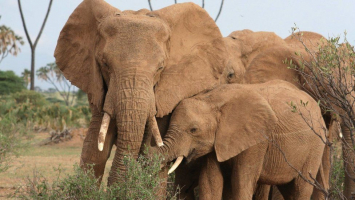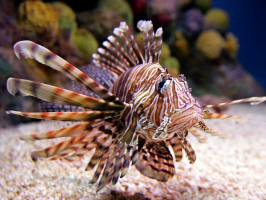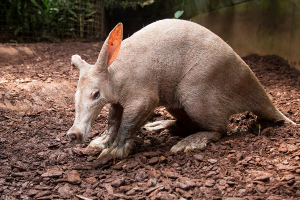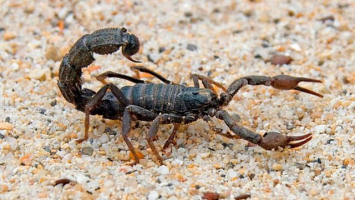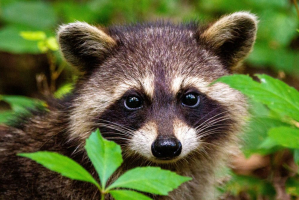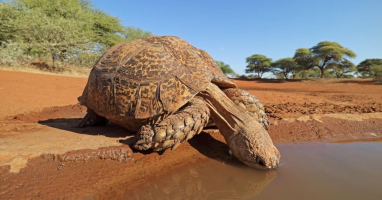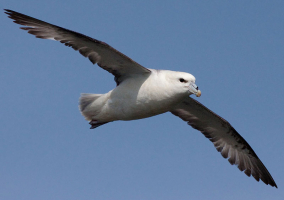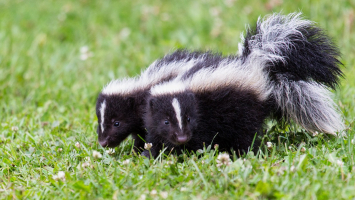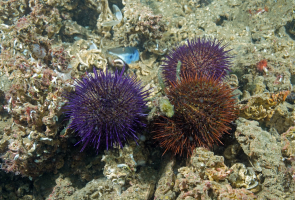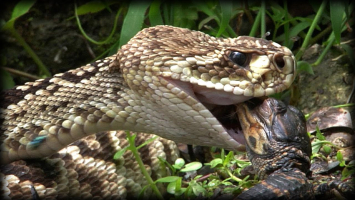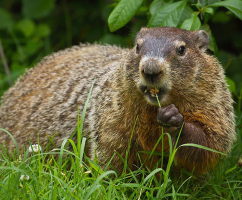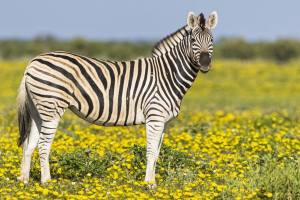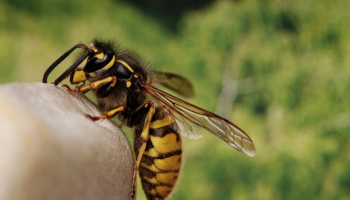Top 9 Predators of Sloths that Eat Sloths
Sloths are arboreal Neotropical xenarthran mammals, constituting the suborder Folivora. They are known for their slow movement and spend the majority of their ... read more...life hanging upside down in the trees of the tropical rainforests of South and Central America. They are thought to be the most closely related to anteaters, making up the xenarthran order Pilosa. Here is a list of predators of sloths that eat sloths.
-
One of the predators of sloths that eat sloths that we would like to introduce to you first is the Harpy eagle. The Harpy eagle (Harpia harpyja) is a neotropical eagle species. The American harpy eagle is also used to distinguish it from the Papuan eagle, sometimes known as the New Guinea harpy eagle or Papuan harpy eagle. It is the largest and most powerful raptor found throughout its range, and one of the world's largest existing species of eagle. It usually lives in the higher (emergent) canopy layer of tropical lowland rainforests. Because of habitat destruction, it has vanished from much of its historic range, and it is nearly extinct in much of Central America. The harpy eagle is also known as a royal hawk in Brazil. Harpia, Harpyopsis, and Morpheus are members of the subfamily Harpiinae.
The Harpy eagle is widespread from Mexico to Central America and into South America, reaching as far south as Argentina. They dwell in the emergent layer of rainforests. They are most common at a height of 900 m (3,000 ft) but have been observed at elevations as high as 2,000 m. (6,600 ft). They search for prey in the jungle, either in the canopy or on the ground, and perch on emergent trees. They do not typically present in disturbed environments, but they do visit semiopen forest/pasture mosaics on a regular basis, primarily during hunting forays. Harpy eagles are at the top of the food chain. A jaguar and an ocelot, on the other hand, grabbed two young eagles being released into the wild as part of a reintroduction program. Its primary prey is tree-dwelling animals, with sloths and monkeys accounting for the majority of its diet.
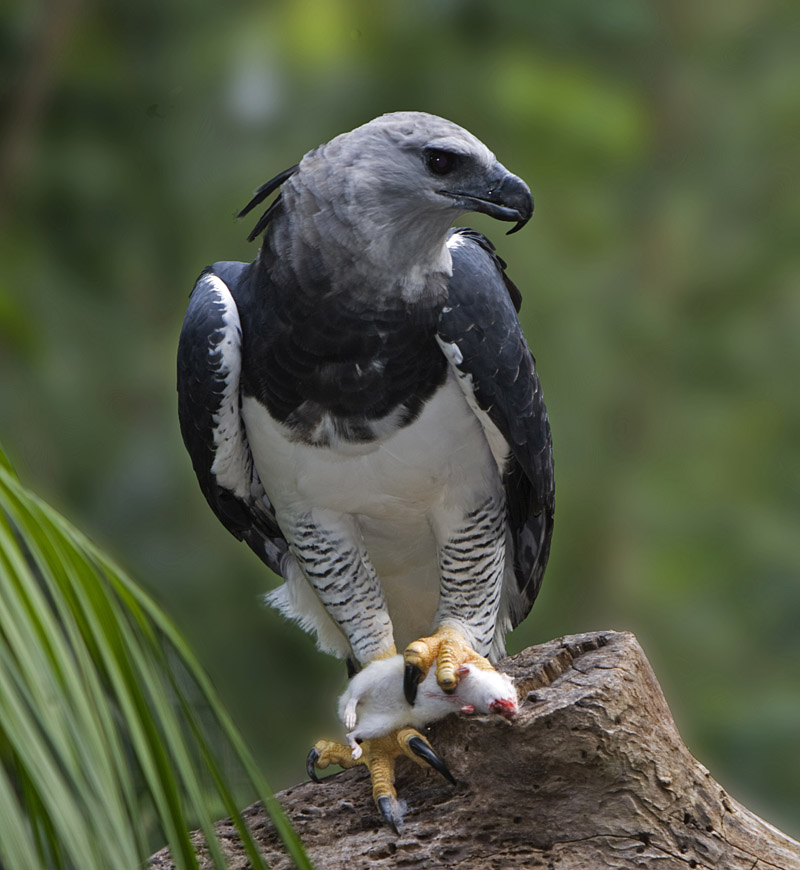
en.wikipedia.org 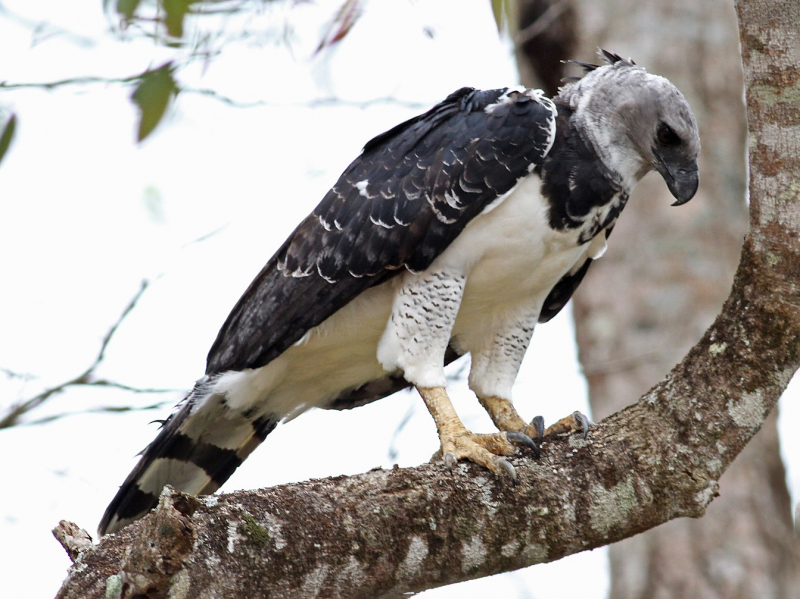
ebird.org -
Puma is a genus in the Felidae family that includes the cougar as its only extant species and may potentially include numerous poorly known Old World fossil members. In addition to these putative Old World fossils, a few New World fossils, such as Puma pumoides and the two species of the so-called "American cheetah," are now classified under the genus Miracinonyx, are possible. Pumas are huge, secretive cats. They are also known as cougars and mountain lions and can grow to be larger than other "big" cat species.
Cats, the fourth-largest member of the cat family, are subspecies of the genus Puma. Adult males can grow to be 7.9 feet (2.4 meters) tall from snout to tail and weigh between 115 and 220 pounds (52 to 100 kg). Females can grow to be around 6.7 feet (2.0 m) long from nose to tail and weigh between 64 and 141 pounds (29 to 64 kg). They also have tails that range in length from 25 to 37 inches (0.6 to 0.9 m). These cats have round heads with upright ears. They have powerful forequarters, necks, and jaws that aid in the capture and retention of prey. They have four retractable claws on both their fore and hind paws.
Because the majority of pumas live in hilly areas, they have thick fur coats that help them retain body heat throughout the cold winters. The puma's fur ranges in color from brown-yellow to grey-red depending on the subspecies and region of its habitat. Individuals who live in colder climates have greyer coats than those who live in warmer regions, who have more red coats. Pumas are ferocious predators with large bodies and powerful short legs. This genus contains enormous and powerful predators. Small creatures such as rats, birds, fish, and rabbits make up the majority of their food. Bighorn sheep, deer, guanaco, mountain goats, raccoons, and coatis can be caught by larger individuals. They occasionally take livestock in locations where there are a lot of them.
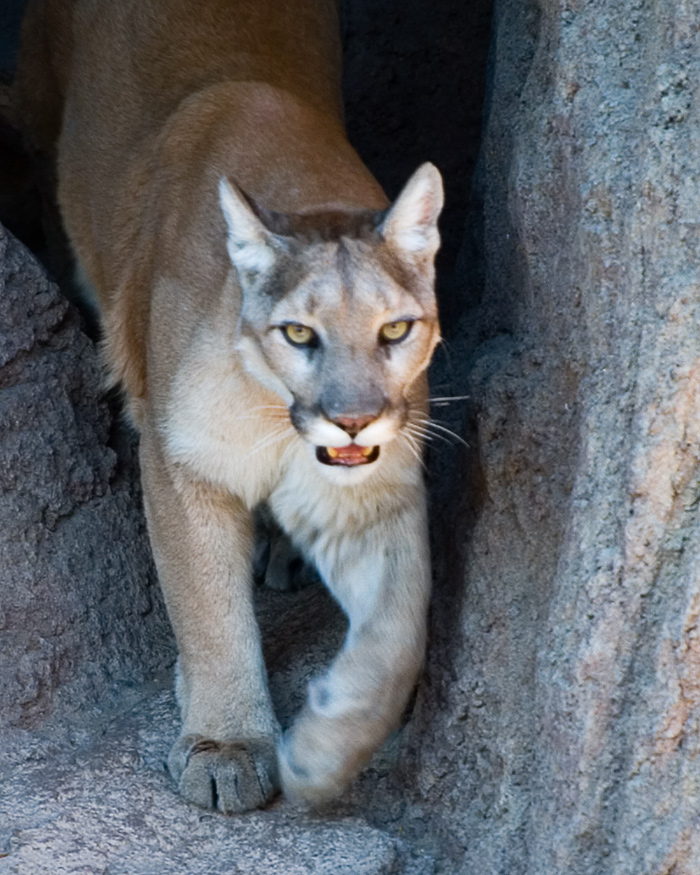
en.wikipedia.org 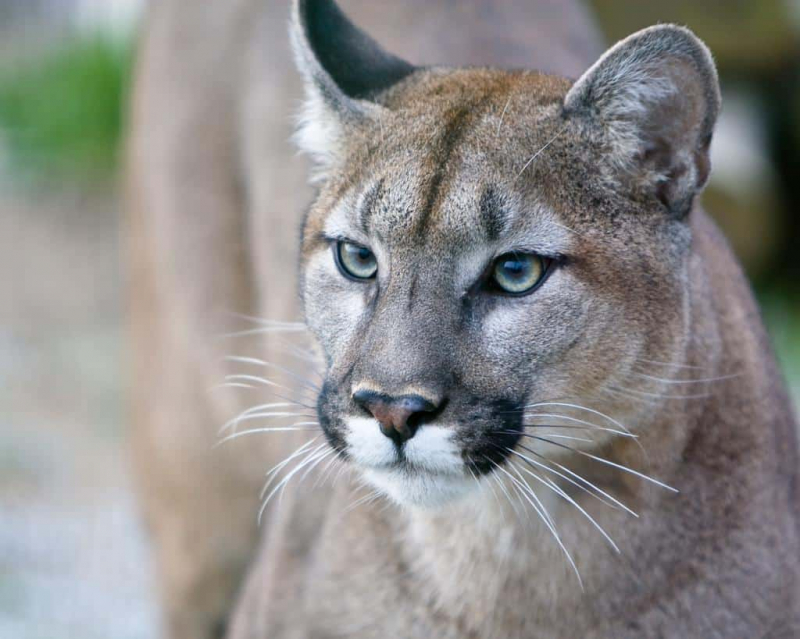
a-z-animals.com -
One of the predators of sloths that eat sloths that you should know is the ocelot. The ocelot (Leopardus pardalis) is a medium-sized spotted wild cat with shoulders measuring 40-50 cm (15.7-19.7 in) and weighing between 8 and 15.5 kg (17.6 and 34.2 lb). Carl Linnaeus described it for the first time in 1758. There are two subspecies recognized. It is native to the southwestern United States, Mexico, Central and South America, as well as Trinidad and Margarita in the Caribbean. It prefers areas with dense vegetation and high prey availability near water sources.
Ocelots have been observed following scent trails in order to catch prey. They walk at a slow pace of about 0.3 km/h (0.2 mph) in search of prey. Alternatively, an ocelot may wait for prey for 30 to 60 minutes at one location before moving to another at 0.8-1.4 km/h (0.5-0.9 mph). To avoid being seen by the prey, an ocelot prefers to hunt in areas with vegetation cover, avoiding open areas, especially on moonlit nights. It preys on small terrestrial mammals such as rodents, lagomorphs, armadillos, and opossums, as well as fish, crustaceans, insects, reptiles, and small birds as a carnivore. It usually feeds on the kill right away, but it first removes the bird's feathers. The ocelot typically preys on animals weighing less than 1 kg (2.2 lb), but it rarely attacks large ungulates such as deer and sheep, as well as peccaries, anteaters, monkeys, and tortoises.
According to Andy, a Natience.com writer, ocelots like to hunt their prey at dusk and at night. They, like leopards, will stalk their prey slowly. In fact, they can stay in one spot for up to an hour waiting for prey to appear. They make it difficult for their prey to notice their presence by remaining in one location and remaining exceedingly calm and quiet. If they see a sloth on or near the ground, they will pounce on them, catching them off guard. A sloth has very little possibility of resisting or escaping from this situation.
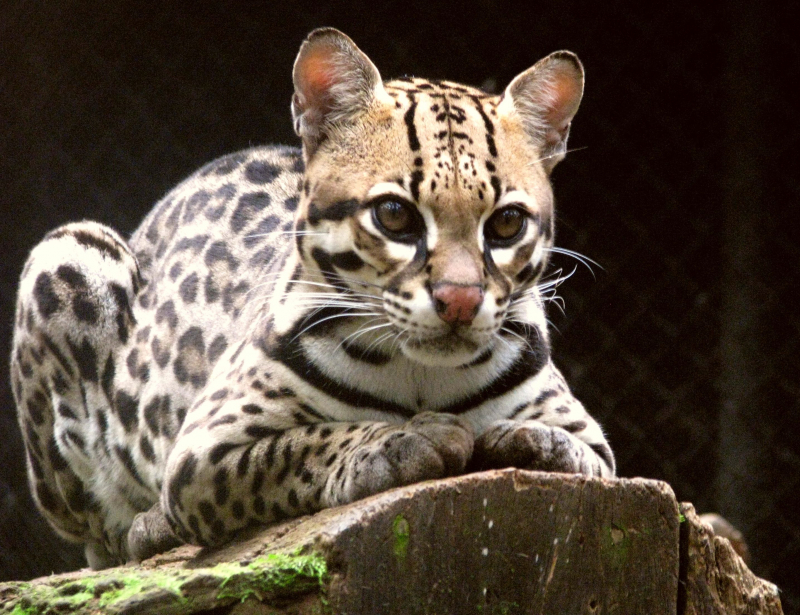
commons.wikimedia.org 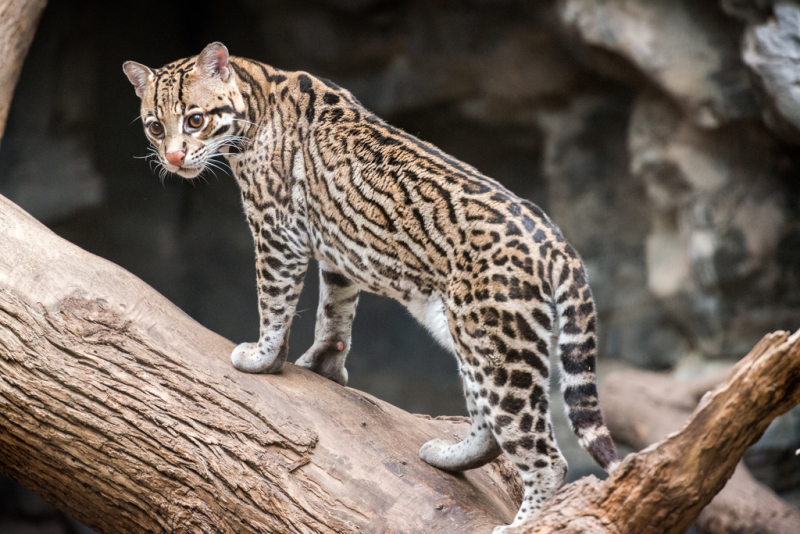
inaturalist.org -
The jaguar (Panthera onca) is a huge cat that is the only extant member of the Panthera genus that is native to the Americas. It is the largest cat species in the Americas and the third largest in the world, with a body length of up to 1.85 m (6 ft 1 in) and a weight of up to 158 kg (348 lb). Its coat is distinguished by pale yellow to tan fur covered by dots that transition to rosettes on the sides, while some individuals have a melanistic black coat. The jaguar's powerful bite allows it to pierce turtle and tortoise carapaces and use an unusual killing method: it bites through the skull of mammalian prey between the ears to deliver a lethal blow to the brain.
It can be found in a range of forested and open habitats, but it prefers tropical and subtropical moist broadleaf forests, wetlands, and woodland areas. It can swim and is primarily a solitary, opportunistic, stalk-and-ambush apex predator. It is a keystone species that helps to stabilize ecosystems and regulate prey populations.
When hunting, the jaguar uses a stalk-and-ambush method rather than chasing prey. Before charging or ambushing, the cat would leisurely travel down forest pathways, listening for and stalking prey. The jaguar attacks from cover and usually from a target's blind spot with a quick pounce; both indigenous people and field researchers regard the species' ambushing abilities as nearly unparalleled in the animal kingdom, and are most likely a result of its role as an apex predator in several different environments. The ambush could include leaping into the water after prey, as a jaguar is capable of swimming with a huge kill; its strength is such that carcasses as large as a heifer can be dragged up a tree to avoid flood levels. The jaguar will drag the remains of its prey to a thicket or other quiet location after killing it.
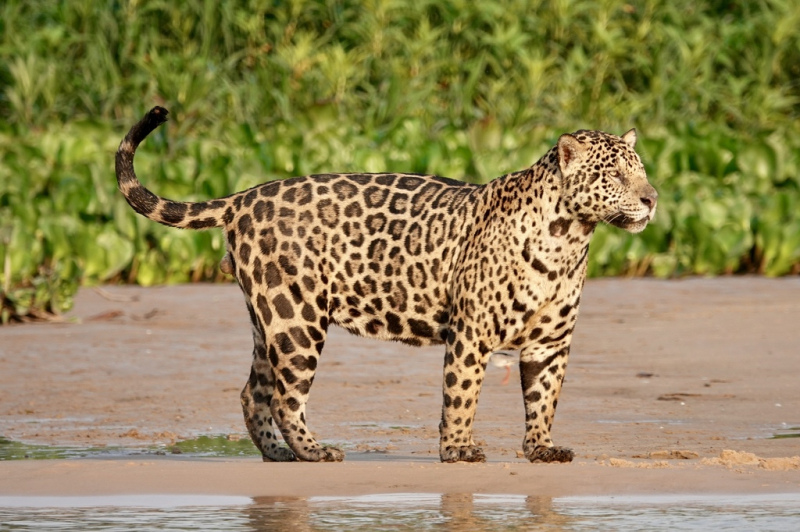
inaturalist.org 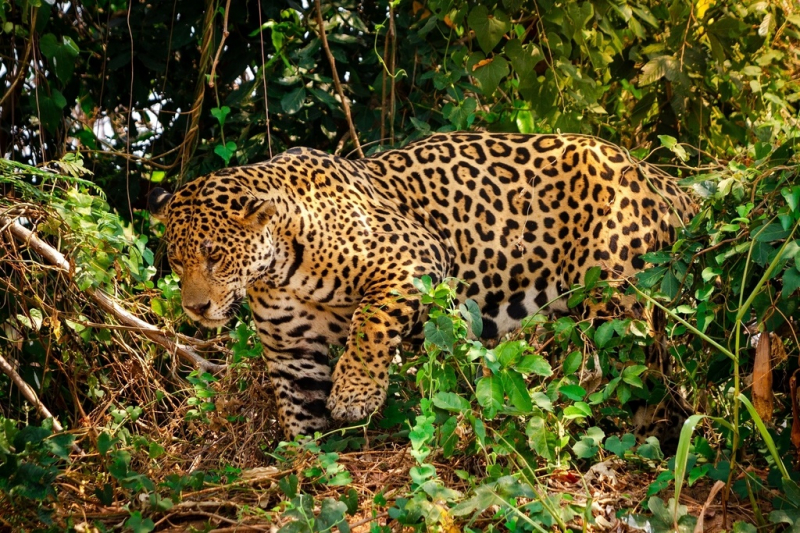
inaturalist.org -
Boa constrictor is one of the predators of sloths that eat sloths. The red-tailed boa, commonly known as Boa constrictor, is a large, non-venomous, heavy-bodied snake that is frequently kept and produced in captivity. The Boa constrictor is a member of the Boidae family, which is found in tropical South America and certain Caribbean islands.
Their prey consists of a diverse range of small to medium-sized mammals and birds. The majority of its diet consists of rodents, but larger lizards and mammals such as monkeys, wild pigs, and ocelots have also been observed to be eaten. Small mice, birds, bats, lizards, and amphibians are among the foods consumed by young boa constrictors. As they grow older and larger, the size of the prey item rises.
Because Boa constrictors are ambush predators, they frequently lie in wait for an opportune prey to appear before attacking. They have also been observed actively hunting, particularly in areas with a low concentration of suitable prey, and this behavior is typically observed at night. The boa first strikes the target, catching it with its fangs, and then constricts it till death before devouring it whole. Constriction can interfere with blood flow and overwhelm the prey's normal blood pressure and circulation, causing unconsciousness and death rather than suffocating, as previously thought. This would quickly result in unconsciousness and death. Their teeth also aid in forcing the animal down the throat, where it is then moved by muscles to the stomach. Depending on the size of the prey and the local temperature, it takes the snake roughly 4-6 days to digest the food completely. Due to its slow metabolism, the snake may not feed for a week to several months after this.
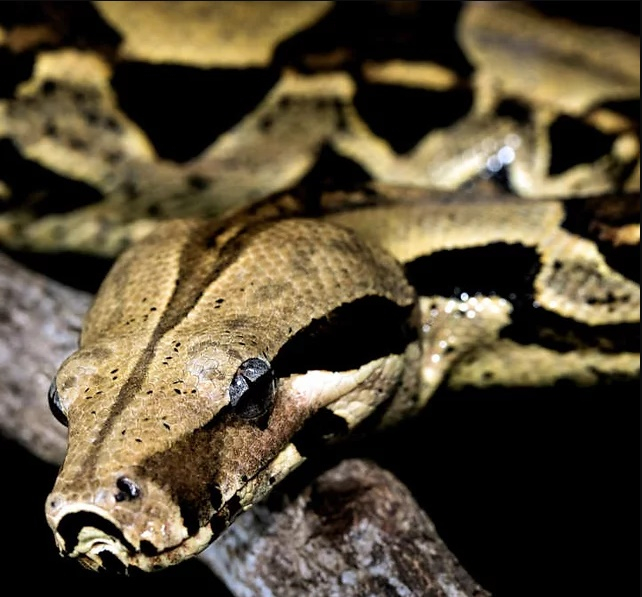
pogonareptile66shop.fr 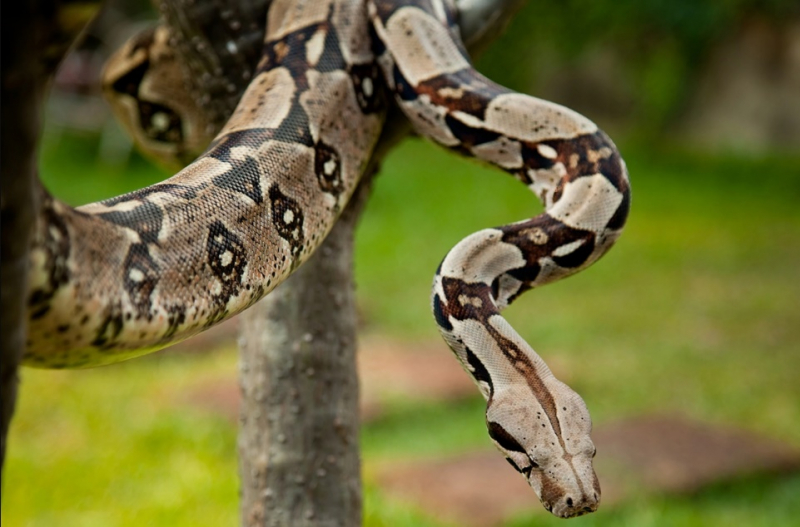
kids.nationalgeographic.com -
The crested eagle (Morphnus guianensis) is a big eagle found in the Neotropics. The crested eagle can reach 89 cm (35 in) in length, 176 cm (69 in) in wingspan and weigh up to 3 kg (6.6 lb). The plumage ranges from light brownish-gray to sooty gray and, in some cases, blackish. It features a white throat, a dark crest spot, and a little dark mask across the eyes. It is found throughout Central and South America, albeit in small quantities. Its diet consists primarily of small animals, rodents, snakes, and smaller birds. Despite their widespread distribution, the IUCN has classified them as Near Threatened, owing primarily to habitat loss.
It is found sparsely throughout its extensive range, which extends from northern Guatemala through Belize, Honduras, Nicaragua, Costa Rica, Panama, Colombia's subtropical Andes, northeastern Venezuela, Guyana, Suriname, French Guiana, Brazil (where it has suffered greatly from habitat destruction and is now found almost entirely in the Amazonian basin), and east Andean Ecuador, southeastern Peru, Paraguay, and eastern Bolivia to northern Argentina.
The crested eagle inhabits humid lowland forests, primarily old-growth tropical rainforests. They can also be found in forest ravines and gallery strips. The species has been seen from sea level to 600 m across most of its range (2,000 ft). They appear to be local dwellers in foothill forests up to 1,000 m (3,300 ft) elevation or even 1,600 m in the Andean countries (5,200 ft). They may have a preference for being near water, such as beaches or rivers.
The crested eagle appears to be a still-hunter, as it has been recorded perched for extended periods of time while visually examining the forest surrounding it. By preying on lesser animals, the crested eagle can escape direct conflict with the harpy eagle.
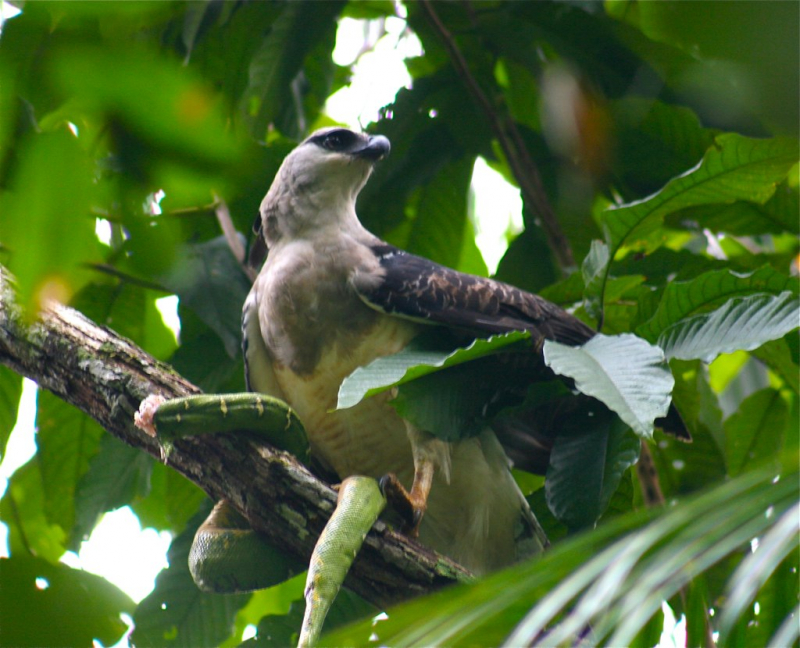
en.wikipedia.org 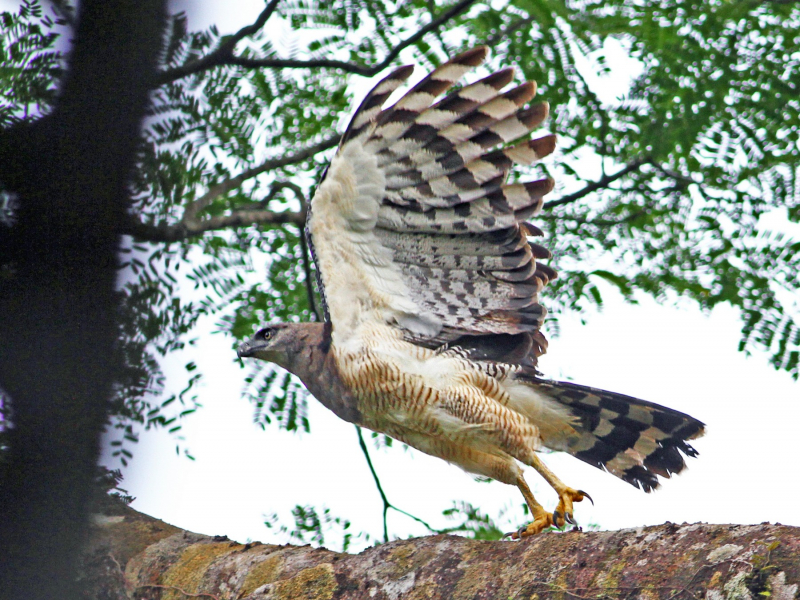
ebird.org -
The spectacled owl (Pulsatrix perspicillata) is a big neotropical bird. It breeds as a resident in woods ranging from southern Mexico and Trinidad to Central America, and south to southern Brazil, Paraguay, and northwestern Argentina. This species is primarily nocturnal, beginning activity around the time of last light at dusk and returning to their roosts around the first light. It is a solitary, unsocial bird that roosts alone each day and only associates with others of its own species for reproductive purposes.
The spectacled owl is the most common and dominant owl in its region, with the larger great-horned owl (Bubo virginianus) very infrequently entering real rainforest settings. The owl usually begins hunting by perching on a branch and examining the area, then dropping with a rapid pounce when prey is found. It mostly preys on mammals, consuming nearly everything that is active at night. Although various rodents are primary, practically every tiny mammal in their habitat is vulnerable.
The Peters climbing rat was by far the most common food in Oaxaca, Mexico, followed by unidentifiable mice opossums. Numerous bats, including bigger spear-nosed bats and broad-eared bats, appear to be susceptible. Tamarins, for example, are small and vulnerable to predation. Prey species can weigh more than 1.5 kg (3.3 lb), with Didelphis opossums, Mephitis skunks, and agoutis weighing up to 2 to 4 kg (4.4 to 8.8 lb) (Dasyprocta ssp.). Even the three-toed sloth (Bradypus variegatus) has been reported to have been killed, notably, an adult female weighing 3.5 to 4.5 kg (7.7 to 9.9 lb), or more than four times the owl's weight. Invertebrates are eaten on a regular basis, second only to mammals, and may consist primarily of caterpillars, but also crabs, snails, huge insects, and spiders.
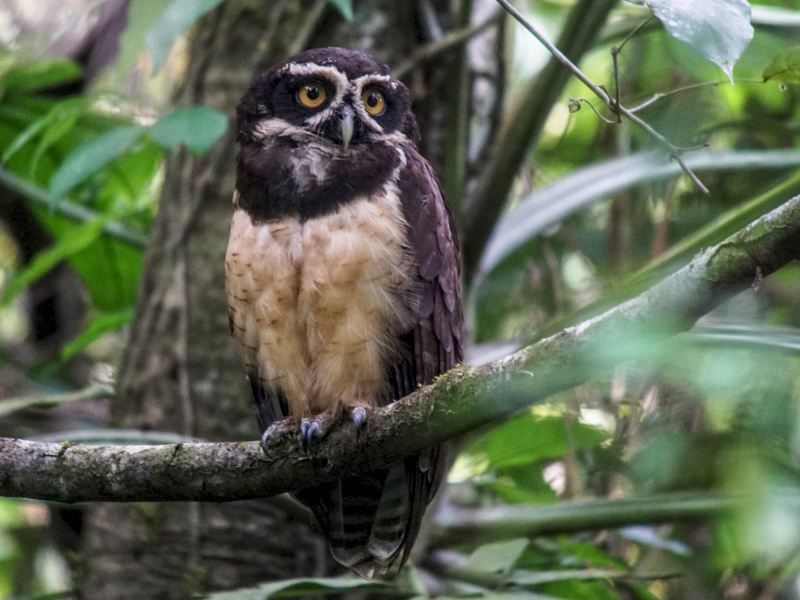
ebird.org 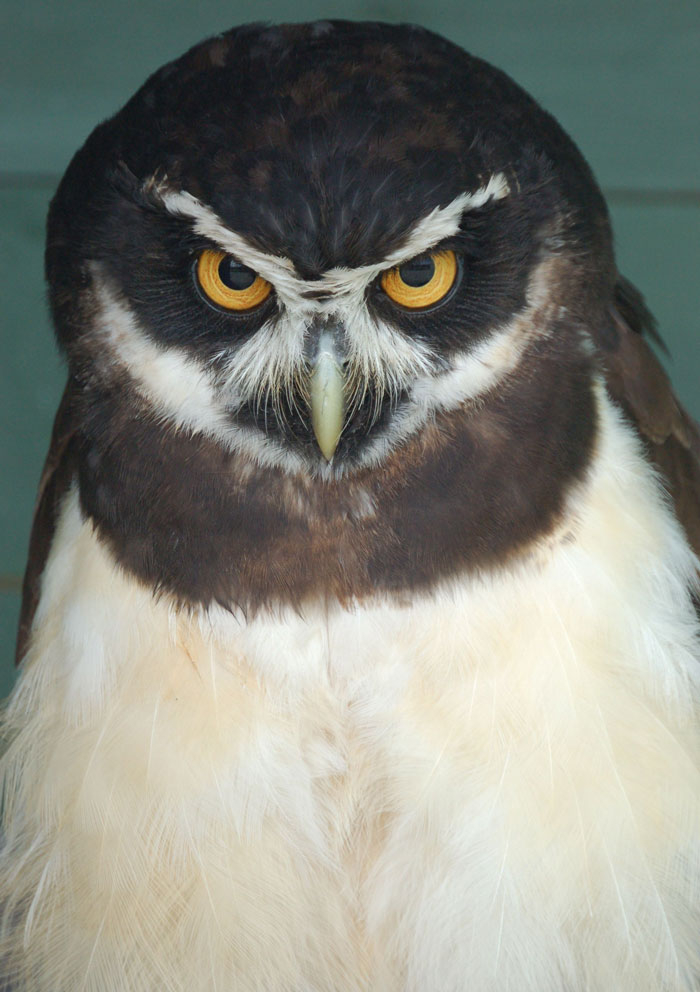
screechowlsanctuary.co.uk -
Margays (Leopardus wiedii) are small wild cats found in Central and South America. It is a nocturnal solitary cat that lives primarily in primary evergreen and deciduous forests. Until the 1990s, margays were illegally hunted for the wildlife trade, resulting in a significant population decline. The margay has been designated as Near Threatened on the IUCN Red List since 2008 because the population is thought to be falling due to habitat loss caused by deforestation. In honor of Prince Maximilian of Wied-Neuwied, who gathered specimens in Brazil, Heinrich Rudolf Schinz adopted the scientific name Felis wiedii in his first scientific description of the margay in 1821.
The margay is primarily nocturnal, though it has been seen hunting during the day in some regions. It prefers to spend the majority of its time in trees, but it does travel on the ground, particularly when traveling between hunting locations. During the day, it sleeps in inaccessible branches or liana clumps. It is typically solitary and has home ranges of 11-16 km2 (4.2–6.2 sq mi). It marks its territory with scents, like urine spraying and scratch marks on the ground or on branches.
The margay is an expert tree climber when it comes to hunting. In fact, sloths avoid predators by hiding high up in the jungle canopy. As a result, they cannot be safe in the canopy until a proficient climber like the margay appears. They can be attacked from above by birds that swoop down, and from below by margays who can climb up and seize them. Although there is evidence of margays hunting and killing sloths, it also feeds on monkeys, birds, eggs, lizards, tree frogs, and arthropods. It also consumes grass, fruit, and other plants, most likely to aid digestion. A story from 2006 of a margay chasing squirrels in its native habitat proved that the margay can chase its prey totally in trees. However, margays have been observed hunting on the ground and eating terrestrial species such as cane rats and guinea pigs.
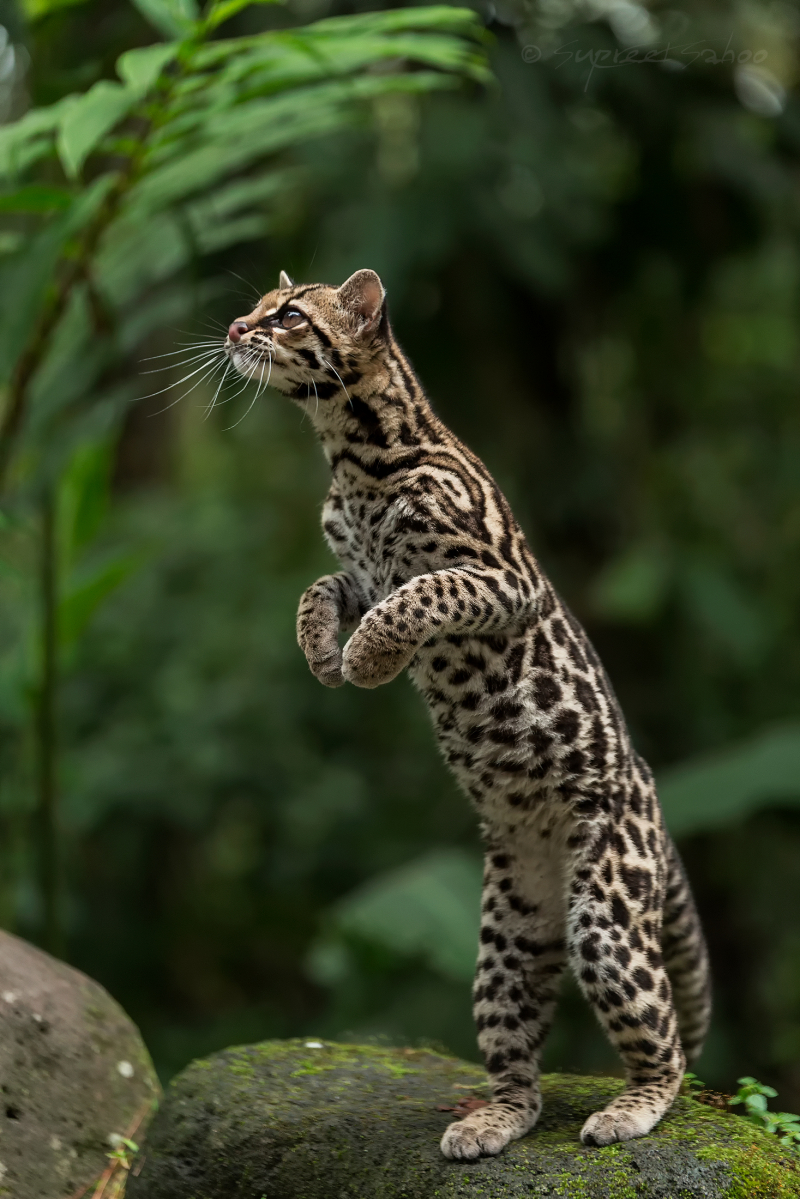
en.wikipedia.org 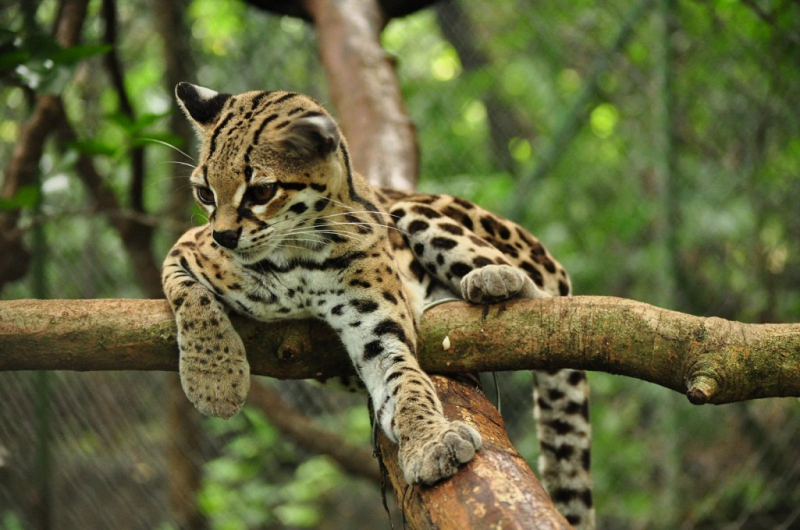
animalspot.net -
Anacondas, often known as water boas, are a genus of enormous snakes. They live in tropical South America. There are now four species recognized. Although the name refers to a genus of snakes, it is frequently used to refer to only one species, the common or green anaconda (Eunectes murinus), which is the world's largest snake by weight and the second longest.
The name anaconda is derived from the name of a snake from Ceylon (Sri Lanka) described in Latin by John Ray in his Synopsis Methodica Animalium (1693) as serpens indicus bubalinus anacandaia zeylonibus, ides bubalorum aliorumque jumentorum membra conterens. Dr. Tancred Robinson provided Ray with a catalog of snakes from the Leyden museum, but the description of its behavior was based on Andreas Cleyer, who described a giant snake that crushed enormous animals by coiling around their bodies and crushing their bones in 1684. According to Henry Yule's Hobson-Jobson, the word gained popularity as a result of a piece of fiction published in Scots Magazine in 1768 by a certain R. Edwin. Edwin described a 'tiger' being crushed to death by an anaconda, despite the fact that tigers were never found in Sri Lanka. Yule and Frank Wall determined that the snake was a python and proposed the Tamil term anai-kondra, which means "elephant killer."
According to Andy, the writer on Natience.com, they are known as water boas and belong to the genus Eunectes. The Eunectes genus includes a group of snakes known as water snakes. Anacondas reside in South America's lush jungles and can be found in the rivers there. Anacondas are classified into four subspecies. The green anaconda is the largest of these. It is the world's heaviest snake and the second longest, after the reticulated python. Sloths, as we all know, enjoy swimming and are pretty proficient at it. Any anaconda that comes upon them in the water will have an easy meal. An anaconda is a type of constrictor. This implies they will coil their entire bodies around their victim until it dies. If they catch a sloth in the water, they have almost no chance of surviving.
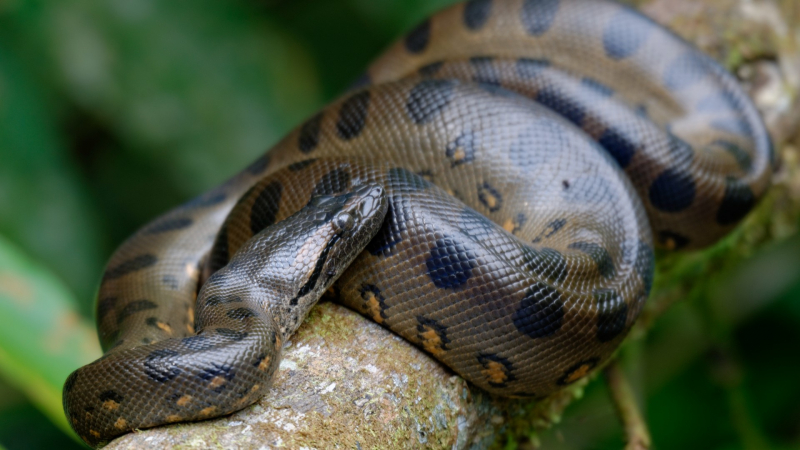
livescience.com 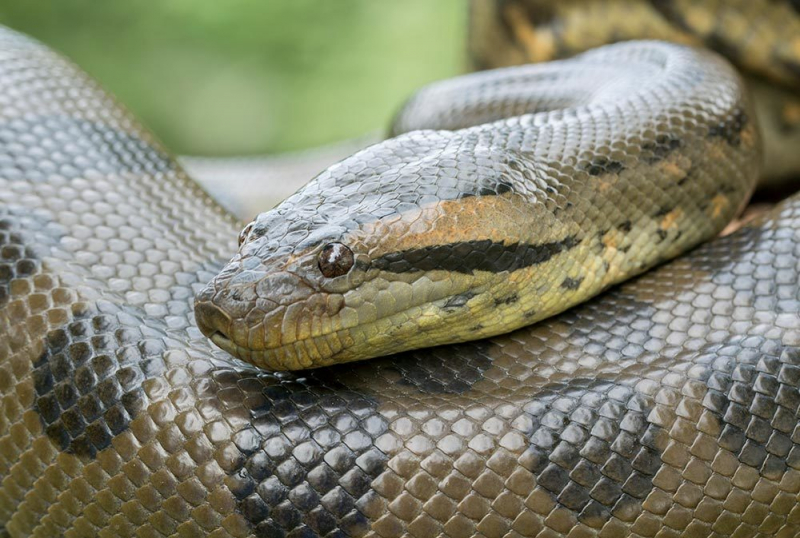
wildrepublic.com











